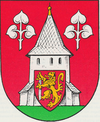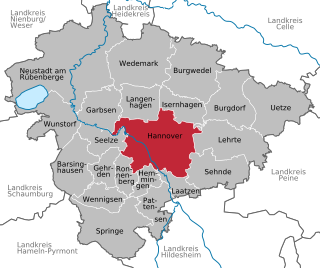
Hanover is the capital and largest city of the German state of Lower Saxony. Its 535,061 (2017) inhabitants make it the 13th-largest city in Germany as well as the third-largest city in Northern Germany after Hamburg and Bremen. Hanover's urban area comprises the towns of Garbsen, Langenhagen and Laatzen and has a population of about 791,000 (2018). The Hanover Region has approximately 1.16 million inhabitants (2019).

Bad Fallingbostel is the district town (Kreisstadt) of the Heidekreis district in the German state of Lower Saxony. Since 1976 the town has had a state-recognised Kneipp spa and has held the title of Bad since 2002. It has close ties to Walsrode, a few miles to the west. Until 2015, there was a British Army base in Bad Fallingbostel, It also hosted Defender 2020 the largest US Army/Nato exercise since the Cold war. The town has around 11,000 inhabitants.
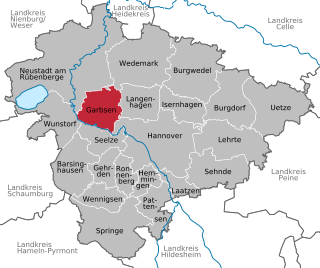
Garbsen is a town in the district of Hanover, in Lower Saxony, Germany. It is situated on the river Leine, approx. 11 km northwest of Hanover.
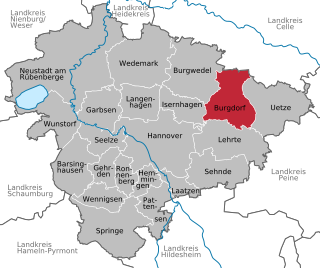
Burgdorf is a town in the Hanover Region, in Lower Saxony, Germany. It is situated approximately 22 km northeast of Hanover. Until 1974, Burgdorf was the capital of the Burgdorf district. The town and its surrounding areas are known for the tradition of growing white Asparagus and for breeding Hanoverian horses. Burgdorf hosts a monthly horse market from April to September every year.
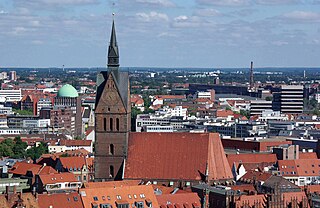
The Marktkirche St. Georgii et Jacobi, commonly known as Marktkirche, is the main Lutheran church in Hanover, Germany. It was built in the 14th century and, together with the nearby Old Town Hall, is considered the southernmost example of the North German brick gothic architectural style. The roof and the vaults of the naves were destroyed in an air raid in 1943 and restored in 1952.

The Hannover–Braunschweig–Göttingen–Wolfsburg Metropolitan Region is an economic and cultural region in Northern Germany. The metropolitan area comprises approximately one third of the area of Lower Saxony, with almost half the inhabitants of the state. It has about 3.9 million people in 20 districts and counties with a total of 431 municipalities and is defined by the German Ministerkonferenz für Raumordnung (MKRO) as a medium urban area in Germany.
The NDR Radiophilharmonie is a German radio orchestra, affiliated with the Norddeutscher Rundfunk (NDR) in Hanover, the capital of Lower Saxony. The orchestra principally gives concerts in the Großer Sendesaal of the Landesfunkhaus Niedersachsen.

The Neustädter Kirche is a main Lutheran parish church in Hanover, Lower Saxony, Germany. The official name is Neustädter Hof- und Stadtkirche St. Johannis zu Hannover. The Baroque church was built in 1666–70. It is one of the oldest Protestant Saalkirchen in Lower Saxony, conceived for the sermon as the main act of the Lutheran church service. Mathematician and philosopher Gottfried Wilhelm Leibniz and Field Marshal Carl August von Alten are buried here.

The Gartenfriedhof or Garden Cemetery is a cemetery in Hanover, created in 1741 and located by the Gartenkirche. The cemetery and the church are both named after the garden parish outside the city walls in front of Aegidien gate. The cemetery, which contains a number of classicising grave markers from the first half of the nineteenth century, was closed in 1864 with the establishment of the Stadtfriedhof Engesohde. Today it forms a park in the middle of inner city Hanover. The graves of Charlotte Buff, the astronomer Caroline Herschel and the painter Johann Heinrich Ramberg are located here. The Gartenfriedhof lies on Marienstraße between Warmbüchenstraße and Arnswaldtstraße.
The following is a timeline of the history of the city of Hanover, Germany.

The Aegidienkirche was a church in Hanover, the capital of Lower Saxony, Germany. It was one of three churches in the Old Town, the others being the Marktkirche and the Kreuzkirche. It was destroyed in World War II, and was left in ruins as a war memorial.

The Kreuzkirche is a Lutheran church in the centre of Hanover, the capital of Lower Saxony, Germany. The Gothic hall church is one of three churches in its Old Town; the other two are the Marktkirche and the now-ruined Aegidienkirche. It was dedicated in 1330 to the Holy Cross.

The Bombing of Hannover was a series of eighty-eight air raids by RAF Bomber Command and the United States Army Air Forces on the German city of Hanover during World War II. 4,748 residents and 2,034 others were killed. Around 1,000 aerial mines, 34,000 high explosive bombs, 900,000 incendiary bombs and 50,000 fire bombs were dropped. The heaviest raid was that by the RAF on the night of 8/9 October 1943, killing 1,245 people. This was an example of the carpet bombing of suburban and residential civilian targets laid out in the 14 February 1942 Area Bombing Directive.
The hübsche families were the third elite class of the Electorate and Kingdom of Hanover in the 18th and early 19th centuries, after the nobility and the clergy. At the time Hanover was in a personal union with the United Kingdom. The group consisted of the higher bourgeoisie and the elite of university-educated civil servants, and played a significant role in the governing of Hanover, often as higher civil servants. The word hübsche literally means courtly and may be loosely translated as "genteel"; it originally meant that someone was presentable at court. The hübsche families have been described as a "state patriciate." In contrast to old noble families which tended to favour military careers, hübsche families placed emphasis on academic education, especially legal education, and favoured careers in the civil service. The hübsche families were a form of Bildungsbürgertum.
Agnes Hundoegger was a German musician and music teacher. As the founder of the Tonika-Do-Lehre, she rendered outstanding services to the elementary musical education.
Heinrich Lutter was a German pianist and piano educator.

Klaus Mlynek is a German historian amd scientific archivist. The long-term director of the Stadtarchiv Hannover is among one of the editors and authors of the Stadtlexikon Hannover, an encyclopdia of Hanover.
Waldemar R. Röhrbein was a German historian. He worked as a museum director in Lower Saxony, his last post being from 1976 to 1997 at the Historisches Museum Hannover, and was president of the Niedersächsischer Heimatbund. He contributed to encyclopedias about Hanover's history and culture.

Historisches Museum Hannover gathers collections on the history of the city of Hanover, Lower Saxony, Germany, including the history of the House of Welf, and of the state of Lower Saxony.
Dirk Böttcher (13 October 1921 – 23 January 2011 was a German printer master, author and president of the association of Friends of the Historisches Museum Hannover.
